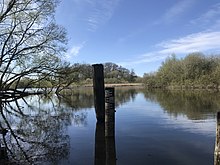Schulensee
| Schulensee | ||
|---|---|---|

|
||
| West part, in the background the telecommunications tower Kiel . | ||
| Geographical location | adjacent to Kiel and the community of Molfsee , Schleswig-Holstein | |
| Tributaries | Eider from Bothkamper See | |
| Drain | Eider towards Westensee | |
| Places on the shore | Kiel | |
| Data | ||
| Coordinates | 54 ° 17 '11 " N , 10 ° 5' 36" E | |
|
|
||
| Altitude above sea level | 11 m | |
| surface | 13 ha | |
| Maximum depth | 2 m | |
|
particularities |
Schulensee nature reserve and surroundings |
|

The Schulensee is a lake on the outskirts of the Schleswig-Holstein state capital Kiel , which is located in the district of Molfsee of the same name . The lake is located in the upper Eider Valley in a basin that was formed during the last ice age .
The Schulensee silted up increasingly in the last decades due to the sediment entry of the Eider. Of the original 35 hectares of the lake, only 13 hectares remain. It has a maximum water depth of only two meters (recent measurements even showed a water depth of the lake of a maximum of 1.60 m). The volume of water has been reduced to a tenth in just a hundred years. The former outlines of the then very large lake can be guessed at from satellite images . What used to be part of the lake area is now a reed-covered moorland. During the Second World War , some aircraft bombs fell on Schulensee. There are four bomb craters on the island that existed 100 years ago, today's Jütwarder inland peninsula . Four to five more can be seen in the surrounding, silted up marshland. The bomb craters are a retreat for many amphibians .
Not only the sediment input of the Eider contributed to the large-scale disappearance of the water volume, but also the straightening / change of the river landscape of the Eider, which lowered the water level by approx. One meter. If one trusts prognoses, in another century most of the lake will have disappeared. The Schulensee was excavated in some places in the past. However, this process was never repeated.
The lake has been part of the 69 hectare nature reserve Schulensee and the surrounding area since 1986 . Only part of the lake can be used by boats. Vehicles with engines of any kind are prohibited.
On various postcards from the turn of the century you can see jetties and boathouses at the Eider outflow, which belonged to the inn there, which are no longer used in this form today. The remains of these wooden walkways are still visible today in the same place on the bank. The Schulensee is only used very rarely as a bathing lake. Due to the very muddy bottom and the shallow water it lost its attractiveness. From the Schulensee you can take a boat trip of around four hours on the Eider to the Westensee .
ecology

The lake is rich in fish and is fished by tenants. Coarse fish such as rudd , roach , bream and carp are particularly common. Pike , eel , perch and pikeperch are found on predatory fish .
The Schulensee is a habitat for water birds, amphibians and insects. Herons , great crested grebes , Canada goose and many other bird species live and nest there. Frogs and toads are increasingly found in the bomb craters from the Second World War around the Schulensee. Among the aquatic plants, the water lilies are dominant, which can be found on the entire lake surface due to the shallow water depth. The dominant riparian plants include reeds and willows. Much of the bank is very muddy, but there are also some sandy sections of the bank.
Due to the broader and much more sediment-rich influence of the Eider in the lake, there is an increased current there due to the thinner outflow of the Eider, and therefore no sedimentation. Therefore, the Eider outflow from the Schulensee has remained the same for centuries. In addition, there are rare mussel species around and in the Schulensee that are on the Red List of Threatened Species in Schleswig-Holstein. The tributary of the Eider keeps the lake free of ice in large areas in winter, so that the open water areas are used by numerous water birds.
See also
Web links
- Schulensee nature reserve and NABU area

